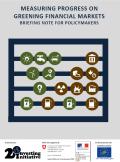
This note prepared for the G20 Infrastructure Working Group summarizes the main finding of the IMF flagships regarding the role of environmentally sustainable investment for the recovery.
Post-COVID financial regulatory policy must incorporate awareness that its starting point is very unusual and different from that in existence pre-corona. The set of financial regulation policies appropriate to this situation requires placing an instrument at the center of the design of financial regulatory policy that effectively internalizes the inter-dependencies in the actions of the financial system.

The global bond market is roughly $100 trillion globally–roughly three times the size of the EU and the United States GDP combined –and it’s been growing by a factor of ten since the early 1990s. Bond markets are a critical source of capital for governments, companies, and financial institutions. Their advantage lies in the relatively long-term tenor of the debt instrument, as well as the market’s liquidity, reducing financing costs. This report focuses on creating a broader understanding of the interface between climate goals and bonds.

A vast amount of investment is needed to tackle the infrastructural and technological requirements to bring about a transition to a low-carbon greener economy. While estimates vary, according to the OECD the total infrastructure investment required for a successful low-carbon transition from 2015 to 2030 is estimated at around $95 trillion, or around $7 trillion per year allocated to projects in the water and waste, telecom, energy and transport sectors. To ensure such a large investment total a vast mobilization of resources as well as private and public sector engagement, collaboration and funding will be necessary. The paper focuses on the case of ‘Use-of-Proceeds Green Bonds’ (UoP GB) that represent 95% of the market in 2016. It discusses the link between increasing investment in UoP-GB on the one hand, and the growth of investments in green projects by issuers, on the other hand, suggesting how this approach can be enhanced to achieve further impact. The paper shows that we currently lack evidence to conclude that as currently designed UoP GB contribute – or can without further enhancement contribute – to scaling up the investments in green projects.

In the context of the G20 Green Finance Study Group, one of the key questions focuses on the challenge of measuring progress around mobilizing capital for ‘green’ investments and shifting capital out of ‘brown’ investments. This briefing note provides a state-of-the-art review on measuring progress on green finance, with a particular emphasis on ‘climate-friendly’ finance. This section briefly reviews what we know about ‘green’ finance across asset classes, with a particular emphasis on questions around high-carbon and low-carbon finance. The next section maps the current options for benchmarking climate finance, as one aspect of the green finance space, to public policy objectives. The note concludes with mapping options for actions for policymakers and international agencies, notably the G20.
